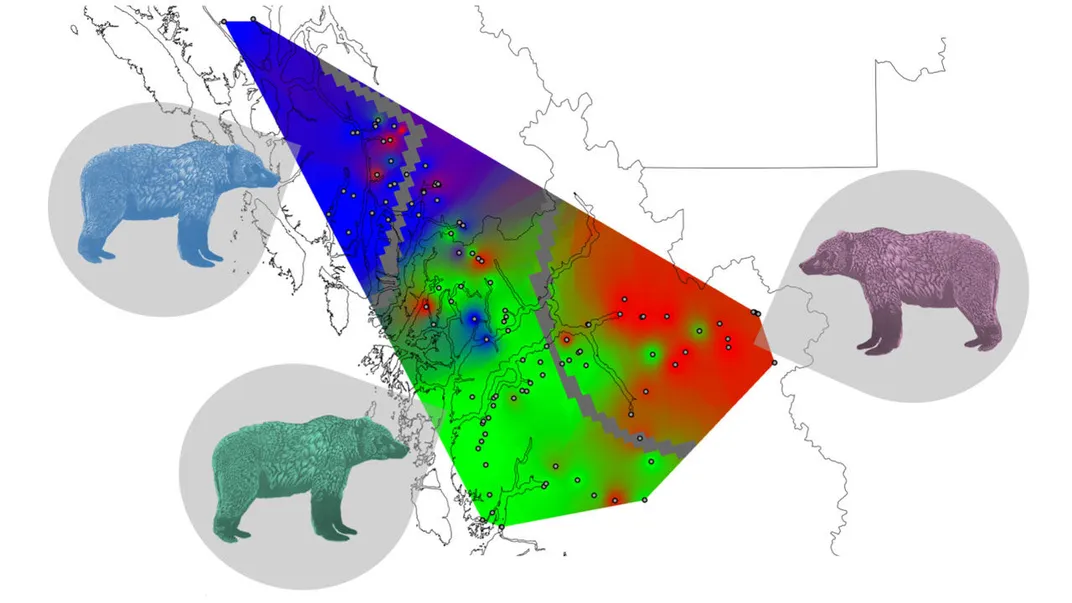Grizzly Bear Territories in Canada Match Maps of Indigenous Language Families
DNA analysis shows a distinct relationship between three distinct groups of grizzlies and Indigenous populations with different languages
/https://tf-cmsv2-smithsonianmag-media.s3.amazonaws.com/filer/8e/5f/8e5f2859-f37e-4488-958c-d0672d1c9030/pexels-patrice-schoefolt-7459670.jpg)
For millennia, Indigenous cultures in North America have had a close bond with nature.
Now, new research has found three genetically distinct grizzly bear territories align with maps of where specific First Nations languages are used in coastal British Columbia. In other words, the grizzlies appear to remain in regions populated by certain indigenous groups.
This “mind-blowing” discovery, made by an international team of scientists, demonstrates just how closely humans and bears are connected—a relationship that members of the Native association First Nations confirm has existed for centuries.
“We and the bears have a lot of the same needs, and it makes sense that we stay fairly close to one area and we have enough resources to feed us,” Jennifer Walkus, a Wuikinuxv scientist on the research team, tells Winston Szeto of CBC News. “It’s definitely in line with the fact that most First Nations consider bears to be family. That is something that we’re very closely tied to.”
Led by Lauren Henson, a University of Victoria doctoral student, the researchers examined hair from grizzly bears collected over 11 years. The team went to remote regions of British Columbia to gather samples from 147 grizzlies over an area of approximately 14,600 square miles—about the size of Vermont.

After analyzing genes as part of a larger DNA study, the scientists were surprised to learn there were three genetically distinct groups of grizzlies. While they could find no geographic barriers to explain the variance, they were astounded to discover how bear territory overlapped with certain Indigenous groups defined by language: Tsimshian, Wakashan and Salishan Nuxalk.
“We were looking at language maps and noticed the striking visual similarity,” Henson tells Rachel Fritts of Science magazine. The team found that while abundant food supplies might keep the genetically distinct bears from roaming to other areas, the fact that they remained exclusively within language family boundaries was remarkable.
“It is an indication of how deep that relationship is between bears and people in the landscape and these resources that they both rely on,” Henson tells Carolina de Ryk, the host of CBC’s "Daybreak North."
Henson and fellow researchers worked in collaboration with members of the Nuxalk, Heiltsuk, Kitasoo/Xai’xais, Gitga’at, and Wuikinuxv Nations to conduct the study, published in the peer-reviewed journal Ecology and Society. The research was supported by Raincoast Conservation Foundation, Hakai Institute and other organizations.
The coastal areas of British Columbia are biologically diverse, which may have contributed to the communal nature of existence between the two species, Henson states.
“Bears are great teachers,” she tells Gloria Dickie of Hakai magazine. “People were using the same watersheds and the same salmon accesses for millennia. So, perhaps it would be more surprising if there wasn’t overlap between bear culture and human culture.”
Many scientists are surprised by the study results. “Mind-blowing” is how Jesse Popp, an Indigenous environmental scientist at the University of Guelph in Canada, described the study, Science reports.
“The findings show how cultural and biological diversity in the region are intertwined,” she tells Sandipan Talukdar of Peoples Dispatch.
/https://tf-cmsv2-smithsonianmag-media.s3.amazonaws.com/accounts/headshot/dave.png)
/https://tf-cmsv2-smithsonianmag-media.s3.amazonaws.com/accounts/headshot/dave.png)